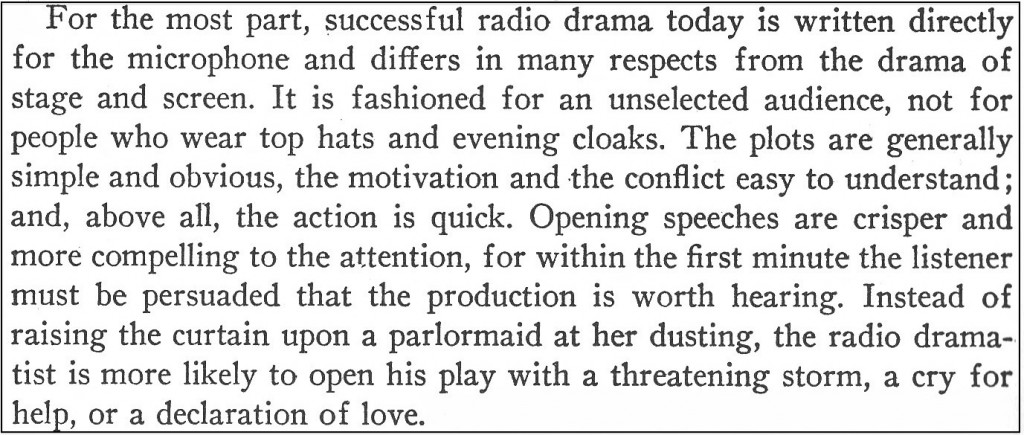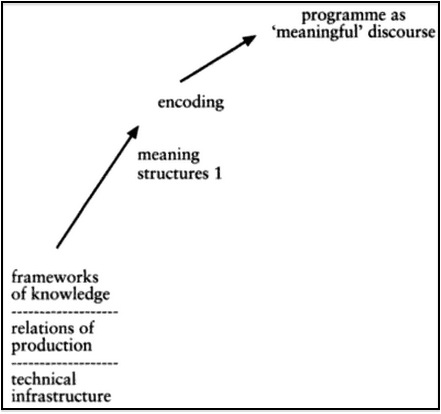New Directions in Media Studies: The Aesthetic Turn
A year ago, Neil Verma and I assembled a panel for the Society for Cinema and Media Studies Conference titled, “The Aesthetic Turn in Radio Studies,” aimed at mapping renewed engagement by radio scholars with concerns traditionally classified under the heading of “aesthetics”: among them, analysis of narrative structure and broadcast genres, methods of spatial and temporal representation, styles of vocal performance, and experiential qualities of radio listening. This turn to questions of aesthetics has also swept the field of television studies, with a proliferation of work on narrative complexity, TV genres, visual style and sound style, performance studies, and viewing experiences engendered by television’s changing technological interfaces. Yet, despite its prominence in contemporary media research, few efforts have been made to trace the origins of this aesthetic agenda or assess its current methods and goals. A genealogy of the aesthetic turn, I suggest, in fact reveals a return to and affirmation of core concerns extending back to the founding moments of American media studies. While recognizing this rich history, in assessing directions for future work on media aesthetics, I wish to argue the value of a specifically production-oriented approach, as an updated project of “historical poetics” that blends traditional tools of textual analysis with methods derived from current work in production studies.
An aesthetic agenda has, to some degree, been a part of the media studies project from the start, even in the “effects” tradition to which subsequent humanities-oriented approaches are commonly contrasted. Hadley Cantril and Gordon Allport’s founding 1935 study, Psychology of Radio, for instance, pursued a detailed investigation of radio’s distinctive modes of affective engagement (its “psychological novelty”) and the presentational styles needed to “conform to the requirements of the medium” (182). In their 1955 Personal Influence, Elihu Katz and Paul Lazarsfeld lauded this attention to the experiential qualities of different media, while reminding researchers that the “content analysis” on which effects research relied also required close attention to “form,” or the presentational techniques used to render content via particular delivery channels (22). Lazarsfeld championed this same approach during his tenure at the Rockefeller-funded Office of Radio Research, warning against exclusive reliance on quantitative studies and courting figures such as Rudolf Arnheim to develop what Rockefeller staff described as a “positive aesthetics of mass communication” that employed humanistic methods to illuminate the communicative properties and possibilities of mass media.† A fully developed program of mass communication research, as Lazarsfeld understood it, would demand strategic forays into the field of aesthetics.

Fig. 1. In a move lauded by Katz and Lazarsfeld, Cantril and Allport’s Psychology of Radio (1935) delineates key differences between storytelling techniques for radio vs. stage and screen entertainment (228).
Despite this early dalliance with humanities-oriented research methods, concerted development in this area was delayed until the television era. Beyond the initial flowering of more literary modes of narrative and genre study in the 1960s-1970s (see, for instance, Lynn Spigel’s discussion of this period), few movements did more to advance the aesthetic agenda than the cultural turn that followed in the wake of work by Raymond Williams and Stuart Hall. As Jonathan Gray and Amanda Lotz note in elaborating the foundations of their own multimodal “television studies approach,” the cultural turn brought not only new methods for analyzing audience “decodings,” but also valuable tools for studying institutional contexts and the “encoding” strategies pursued by media producers. From John Fiske and John Hartley’s work on semiotics, to new models of genre study by Julie D’Acci, Robert Allen, and Jason Mittell, cultural studies scholars have encouraged close reading and critical interpretation of media texts, while working to situate these texts within their larger industrial and cultural contexts. Importantly, then, concerns with questions of aesthetics in contemporary media studies represent not a radical correction and repudiation of the cultural turn, but rather a strategic renewal and intensification of founding tendencies within this movement.

Fig. 2. Cultural Studies interventions: The “encoding” half of Stuart Hall’s Encoding/Decoding model (1973) calls for combined attention to media texts and their underlying institutional contexts.
The rise of production studies in recent years has offered further opportunities for enriched modes of aesthetic analysis. From John Caldwell’s seminal work on production culture, to Havens, Lotz, and Tinic’s influential “mid-level” approach, production studies scholars have argued the need to supplement structural analyses of media ownership and regulation with detailed studies of craft practices – moving industry studies, in effect, from the corporate boardroom to the studio floor. When coupled with methods of close textual analysis, consideration of struggles on the set and the “self-theorizing talk” (Caldwell) of producers in interviews and trade journals offers valuable tools for understanding, as Havens et al put it, “in an aesthetic sense . . . how particular media texts arise” and achieve dominance (237) – illuminating, in other words, the processes through which particular sets of programming forms and production styles are consolidated, and connecting them to the larger modes of production of which they are a part.

Fig. 3. A production-oriented approach to media aesthetics: Applying new tools for industry analysis from contemporary production studies, while reintegrating close analysis of resulting textual forms.
While most production studies work has remained focused on contemporary media and has yet to fully cultivate the aesthetic component of its research agenda, a production-oriented approach to media aesthetics holds great promise and may be of particular value for historical work. As an updated project of historical poetics, this approach combines close analysis of surface-level textual phenomena (the “what” of media programming) with critical study of the production techniques and institutional logics behind them (their “how” and “why”), isolating privileged formal properties and possibilities of media while recognizing these as historically contingent products of industrial sense-making and consent-winning. However, such an approach remains every bit as much “aesthetics” as “industry studies.” In a field increasingly occupied with an aesthetic agenda, why not call this certain tendency by name and begin serious discussion of its nature and future?
______________
† John Marshall, “Postwar Work in Film and Radio,” Memo to David H. Stevens, December 16, 1943, and “Interview with Rudolf Arnheim, January 3, 1944, Series 200R, RG 1.1, Rockefeller Foundation Archives. Thanks to Josh Shepperd for his assistance in procuring these documents.




Excellent summation of the ramifications of the last decade or so of media studies. I particularly appreciate the broad historical context (all the way back to Lazarsfeld and Arnheim), and the reminder that “encoding” was indeed half of Hall’s proposed model. That said, in a context of a saturated environment of what we might call “encoding stories”–in the trade and fan press, in social media, in TV recap criticism, etc.–we still need to work to better contextualize contemporary critical engagements. That is, are we (collectively) imbibing and producing so much of this context that we might be losing sight of the broader roles of media in/as culture, as well as the specific moments of media texts, forms, and practices that simply fall outside the critical spotlight?
Thanks for your thoughtful comment, Derek. As I understand you here, you’re suggesting that an attention to “aesthetics” may be misplaced and lead to unwitting complicity with the industries and cultural forms that should be singled out for scholarly critique? Of course, I’m not sure the aesthetic agenda has ever quite gotten its full due in media studies, despite some of the early inroads made by BCCCS researchers that I’d gestured to above (as well as some of the early mass comm scholars before them). For this reason, I’ve been encouraged by growing scholarly attention to questions of narrative, style, etc. While I don’t think that aesthetic analysis necessarily demands a critical agenda or should be valued solely on the basis of whether or not it has one, to fully grasp the larger social impact of media does require a detailed understanding of the texts themselves . . . . so, whether it’s a proximate or ultimate goal, understanding textual forms remains a vital part of the media studies agenda, and some of the new tools afforded by current production studies can be a valuable aid in this effort.
I’d agree that there’s a strategic demystification of the production process in many trade presses and popular media forums (“encoding stories” as you call them), which are not designed to produce a critical consciousness of the production process so much as to reinforce dominant ideologies within a given production culture and renew the allure of the media product for its intended consumer. However, I’m not sure scholarly studies of production practices and textual forms necessarily risk complicity here; rather, it strikes me that we could just as easily see the prevalence of those encoding stories as evidence of the increased URGENCY for more scholarly accounts that can provide some critical and historical perspective lacking in the trade stories and popular press coverage. (I suspect we may be in agreement on this point.) Agreed, as well, that it’s important to remain sensitive to media texts, forms, and practices that lie beyond our immediate critical agenda (and to interrogate our own biases in terms of which texts and practices we’re singling out for analysis and which fall by the wayside) . . . . but, by the same token, don’t the dominant texts, forms, and practices, by virtue of their dominance, also warrant particular critical attention? I’d suggest that a “history of the dominant” certainly has its place in analyses of aesthetic form.
A deeper issue you’ve raised here may concern the relationship between the “encoding” and “decoding” moments of Hall’s original model, which of course configured them within a “circuit” where one moment constantly shaped the conditions and possibilities of the other. A more culturalist and reception-oriented study, then, would by no means be foreign to the project of aesthetic analysis, although for the production-oriented approach I’ve proposed here I’d want to ask how that second moment in the circuit in turn impacts the creative choices made by producers and the design of the text itself. In a sense, this would be the difference between the two larger branches of “aesthetics” as traditionally defined: one concerned with understanding the nature of the art object, the other concerned with understanding the nature of aesthetic experience. If it’s aesthetic experience that concerns us, I think attention to the moment of reception can be especially illuminating; for understanding the art object itself, I think we may be better served by a production-oriented approach (albeit one sensitive to the larger sociohistorical pressures that producers negotiate).
I’m not up on the state of media/cultural studies, so this is an interesting glimpse into the field. Reading from “across the tracks” (so to speak), though, it’s worth pointing out that film studies (especially at UW-Madison) has long hosted the sort of “production-oriented research” into aesthetics that you’re calling for. Bordwell, Staiger, and Thompson’s THE CLASSICAL HOLLYWOOD CINEMA: FILM STYLE & MODE OF PRODUCTION TO 1960 is probably the most famous example, in addition to being one of the most exhaustive.
The film studies affinities are definitely worth foregrounding, Leo. For a discussion of historical poetics, I’d linked to Bordwell’s piece in THE CINEMATIC TEXT, but THE CLASSICAL HOLLYWOOD CINEMA does predate that and gets into production-oriented issues in much more detail. Rather than peering across the tracks, I think it’s worth considering media studies as a field fed by many different tracks. Film studies is certainly one of those, offering useful models for discussing the formal dimensions of media practice and connecting them to their larger production contexts (models that I think have had an undeniable influence on much of the current scholarship in the field). A more exhaustive genealogy of the aesthetic turn might interrogate those connections at greater length. The line between “film studies” and “media studies” is often a fairly thin one, for that matter, so it might behoove us to consider the extent to which (or under what circumstances) we’re invested in maintaining that distinction.